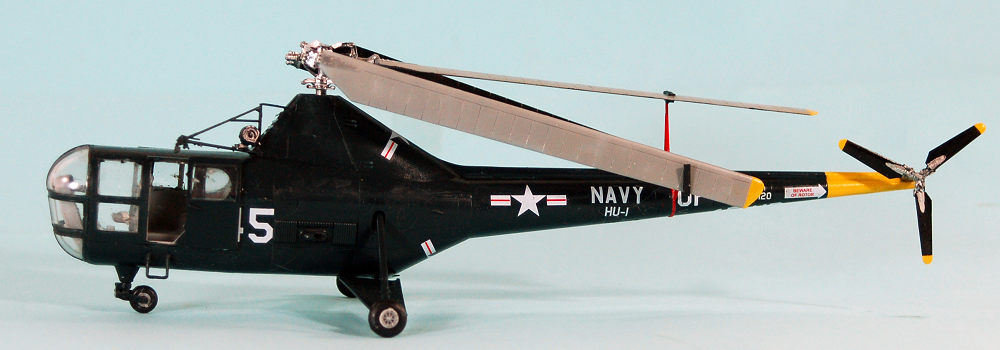
| KIT #: | 48001 |
| PRICE: | @$30.00 |
| DECALS: | Three options |
| REVIEWER: | Tom Cleaver |
| NOTES: | New Tool |

| HISTORY |
The “Horse”:
The H-5 was originally built by Sikorsky as its model S-48,[4] designated as the R-5 by the United States Army Air Forces. It was designed to provide a helicopter having greater useful load, endurance, speed, and service ceiling than the Sikorsky R-4. The R-5 differed from the R-4 by having an increased rotor diameter and a new, longer fuselage for two persons in tandem,[2] though it retained the R-4's tailwheel-type landing gear. Larger than the R-4 or the later R-6, the R-5 was fitted with a more powerful Wasp Junior 450-hp radial engine, and quickly proved itself the most successful of the three types.
Sikorsky soon developed a modified version of the R-5, the S-51, featuring a greater rotor diameter, greater carrying capacity and gross weight, and a redesigned tricycle landing gear configuration; this first flew on 16 February 1946.[2] With room for three passengers plus pilot, the S-51 was initially intended to appeal to civilian as well as military operators, and was the first helicopter to be sold to a commercial user.[6] Eleven S-51s were ordered by the USAF and designated the R-5F, while ninety went to the Navy as the HO3S-1, commonly referred to as the “Horse.”
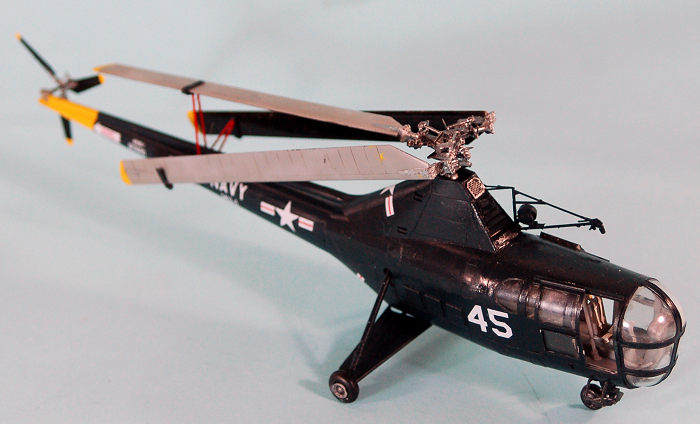 The U.S.
Navy ordered four S-51s "off-the-shelf" from Sikorsky in late 1946 for use in
the Antarctic and Operation Highjump, placing them into naval inventory as the
HO3S-1.[7] Carried aboard the seaplane tender USS Pine Island, on Christmas Day
1946 an HO3S-1 of VX-3 piloted by Lieutenant Commander Walter M. Sessums became
the first helicopter to fly in the Antarctic. Having proved its capabilities,
the initial naval HO3S-1 order was followed by subsequent purchases of an
additional 42 aircraft in 1948.[8] The Navy equipped several warship classes
with HO3S-1 utility helos, including aircraft carriers, seaplane tenders,
icebreakers, Des Moines class cruisers,
and Iowa class battleships.
The U.S.
Navy ordered four S-51s "off-the-shelf" from Sikorsky in late 1946 for use in
the Antarctic and Operation Highjump, placing them into naval inventory as the
HO3S-1.[7] Carried aboard the seaplane tender USS Pine Island, on Christmas Day
1946 an HO3S-1 of VX-3 piloted by Lieutenant Commander Walter M. Sessums became
the first helicopter to fly in the Antarctic. Having proved its capabilities,
the initial naval HO3S-1 order was followed by subsequent purchases of an
additional 42 aircraft in 1948.[8] The Navy equipped several warship classes
with HO3S-1 utility helos, including aircraft carriers, seaplane tenders,
icebreakers, Des Moines class cruisers,
and Iowa class battleships.
The HO3S-1 gained its greatest fame during the Korean War when it was called upon repeatedly to rescue United Nations pilots shot down behind enemy lines and to evacuate wounded personnel from frontline areas. It was eventually replaced in most roles by the H-19 Chickasaw. In 1957, the last HO3S-1 helicopters were retired from active Navy and Marine service.
The Real “Chief Forney”:
At the end of January 1952, correspondent James Michener reported aboard USS Valley Forge (CV-45), having departed Essex at the conclusion of her December tour of operations with TF 77. “Happy Valley” was then at Yokosuka following the first tour of her third deployment to Korea. Michener was reporting for UPI and the Saturday Evening Post as well as Reader’s Digest. Over the course of the next 45 days, during which time operations would leave crew members calling their ship “Death Valley,” he would find much to write about, and would leave the ship with the necessary details and information to create “The Bridges At Toko-ri.” Among the Naval Aviators he met on “Happy Valley” was Lieutenant Donald Brubaker, a reservist flying Skyraiders with VF-194, who happened to be a lawyer from Denver, Colorado.
8 February 1952 would be one of the worst days of the entire deployment for Valley Forge’s air group, and was the first time anyone made mention of the carrier as “Death Valley.”
That morning, word came through U.S. Army intelligence that VF-194's Lt(jg) Harry Ettinger, who had been thought lost on 13 December, had instead been been badly injured getting out of his Skyraider, and was now suffering from pneumonia and frostbite, after rescue from prison camp by anti-communist Korean guerillas who had kept him hidden in the mountains. His rescuers attempted to carry him by litter to Wonsan, but were unable to find a way to get past the many small villages to the coast, since they were being pursued by North Korean troops. Happy Valley’s air group would provide cover for the HO3S-1 helicopter from USS Rochester (CA-124) flown by Chief Naval Aviation Pilot Duane Thorin. Michener had previously met Thorin, who was equally well-known throughout the fleet for his ability to pluck men from behind enemy lines and for rendering commanding officers apoplectic when he exchanged his helmet for a Kelly Green baseball hat after lifting off the ship.
 Chief
Thorin was dismayed when the Army Intelligence commander told him to take 1st
Lieutenant Albert W.C. Naylor-Foote with him to contact the guerillas. Thorin
pointed out he couldn’t take Naylor-Foote and his crewman and still have room
for Ettinger, and that Crawford was needed if they were to make an aerial rescue
using the sling. When told they would land to pick up Ettinger, he relented, but
then had another argument about the amount of medical supplies and a radio
Naylor-Foote wanted to bring along for the guerillas.
Chief
Thorin was dismayed when the Army Intelligence commander told him to take 1st
Lieutenant Albert W.C. Naylor-Foote with him to contact the guerillas. Thorin
pointed out he couldn’t take Naylor-Foote and his crewman and still have room
for Ettinger, and that Crawford was needed if they were to make an aerial rescue
using the sling. When told they would land to pick up Ettinger, he relented, but
then had another argument about the amount of medical supplies and a radio
Naylor-Foote wanted to bring along for the guerillas.
At 0600 hours, shortly after dawn, Thorin lifted off Rochester and headed toward the coast. A six-plane RESCAP of three VF-194 Skyraiders and three VC-3 F4U-5N Corsairs from Valley Forge joined up as he crossed the shoreline at 10,000 feet. Dropping lower, he spotted the thatched-roof hut the guerillas had set afire to mark their location. Reconnoitering the fresh snow, he saw no other footprints in the area and came in to pick up Ettinger. As he did so, he spotted a North Korean patrol in a village; he estimated it would take them 30 minutes to get to the rescue site, enough time to pick up Ettinger and get away. Before going in for the pickup, he ordered Naylor-Foote to drop the 150 pounds of gear, since it would be impossible to rescue Ettinger otherwise.
Bringing the “Horse” in as close to the burning hut as possible, Thorin held it on the edge of a small terrace while Ettinger hobbled to them on his frostbitten feet. As he climbed aboard, the HO3S-1 dipped, dangerously out of balance since Naylor-Foote hadn’t dropped the supplies. The helicopter was unable to maintain hover in this situation. As Thorin maneuvered to bring it around again, he moved out of “ground effect” where he had been hovering, and they crashed into the ravine below as the rotor blades caught the side of the ravine and shattered. Thorin called in the RESCAP and the planes strafed the North Korean patrol which had left the village to investigate the burning hut. Thorin pulled Naylor-Foote and Ettinger from the wreck. “The explosive rounds sounded like popping corn, and shrapnel sizzled through the trees above us, close enough that I felt the breeze.”
Upon learning of Thorin’s crash, LST-799 in Wonsan Harbor sent her HO3S-1 to attempt a rescue. The helicopter was halfway there when it was struck by anti-aircraft fire and damaged so badly it had to land on Rochester. There was no other immediate way to rescue the men, and a RESCAP was organized for the rest of the day while calls were made to see if another helicopter could be found.
Another attempt was made to rescue Thorin and Ettinger. Word was received at HMR-1's field of the need for a helicoper. Pilot Lt. Colonel William P. Mitchell and co-pilot Captain Robert F. Warren and crew chief, Technical Sergeant Walter F. Mortimer took off with the squadron doctor, Lieutenant Burt C. Johnson to attempt the mission. They rendezvoused with eight Corsairs over K-50 and headed north. Enroute, they were diverted to the Rochester, where they were briefed on the situation. Despite the difficulty, Colonel Mitchell elected to make the attempt.
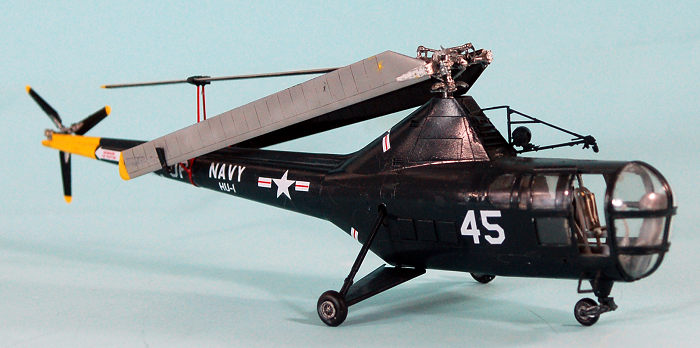 Once
they were near the crash site, the escorting Corsairs strafed the enemy troops
that were visible on the surrounding ridges while Mitchell orbited at a thousand
feet. Thorin later remembered, “A Marine helicopter came looking for us, moving
upslope over the open area about 200 yards outside of our hideaway. It was an
HRS-1 and had capability of taking all three of us.” Mitchell made a second
approach and flew from south to north over Thorin’s wrecked helicopter. Crew
chief Mortimer reported enemy troops in holes on the ridges on both sides of
Once
they were near the crash site, the escorting Corsairs strafed the enemy troops
that were visible on the surrounding ridges while Mitchell orbited at a thousand
feet. Thorin later remembered, “A Marine helicopter came looking for us, moving
upslope over the open area about 200 yards outside of our hideaway. It was an
HRS-1 and had capability of taking all three of us.” Mitchell made a second
approach and flew from south to north over Thorin’s wrecked helicopter. Crew
chief Mortimer reported enemy troops in holes on the ridges on both sides of
the valley. The fighter escorts made additional passes and Mitchell moved the big blue helicopter around a draw and up the stream bed in the valley floor.
Thorin realized that he and the others were now bait in a trap, since they were surrounded on all sides by hidden North Korean troops. “If we were to break out into the open area where this helicopter could pick us up, both it and ourselves would be a well-centered target for all of the troops in the vicinity. All things considered, it seemed best to let the Marine helicopter pass on by.” At the same time, Mitchell reported he saw no activity at the crash site and broke off the attempt When he flew off, Thorin and Ettinger stood up and raised their hands.
Valley Forge. Philippine Sea and Antietam had flown 70 RESCAP sorties through the day in the unsuccessful rescue attempts. The next morning, when Valley Forge withdrew for replenishment, she launched eight VF-194 Skyraiders to search for the downed men. Initially, the searchers reported all three men at the Thorin site had been killed when they saw the snow saturated red that appeared to be blood from a massacre; it was actually marker dye from their life vests.
 James
Michener reported the “deaths” in a UPI article, “An Epic in Failure” and a
short story,“Heroes Fail to Save Pal,” first published in the July 1952
Reader’s Digest: “Here was complete failure…
Helicopter[s], planes and men were lost in the futile tragedy. The enemy had a
field day and we had nothing. Nothing, that is, except another curious
demonstration [that] sometimes defeat does actually mean more to democracy than
victory.” The story eventually evolved into the sad finale of “The
Bridges at Toko-Ri.”
James
Michener reported the “deaths” in a UPI article, “An Epic in Failure” and a
short story,“Heroes Fail to Save Pal,” first published in the July 1952
Reader’s Digest: “Here was complete failure…
Helicopter[s], planes and men were lost in the futile tragedy. The enemy had a
field day and we had nothing. Nothing, that is, except another curious
demonstration [that] sometimes defeat does actually mean more to democracy than
victory.” The story eventually evolved into the sad finale of “The
Bridges at Toko-Ri.”
In truth, all had been captured and made prisoner. In June 1952, Thorin escaped for three days before being recaptured and returned to the camp where he was tortured for making the attempt. In August 1953, just after publication of the novel and its sale to Hollywood, they walked across the bridge at Panmunjom to freedom. Ettinger’s two crewmen, Jess R. McNelroy and Julian Gilliland, had also survived capture and prison camp.
After the war, Duane Thorin participated in the development of the Navy’s Survival, Evasion, Resistance and Escape (SERE) training and the development of the official Code of Conduct for POWs. He later worked for the National Security Agency, where he lectured about treatment of POWs by the North Koreans and Chinese.
| THE KIT |
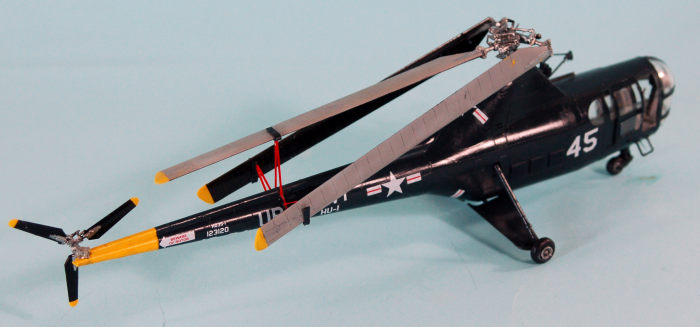 There
have been several other HO3S-1 kits made over the years. I am aware of a resin
kit by Mike Belcher, and a limited-run injection molded kit from Fonderie
Miniatures. Both have problems. This kit from AMP solves those problems, and is
the best kit available of this famous helicopter.
There
have been several other HO3S-1 kits made over the years. I am aware of a resin
kit by Mike Belcher, and a limited-run injection molded kit from Fonderie
Miniatures. Both have problems. This kit from AMP solves those problems, and is
the best kit available of this famous helicopter.
The forward section of the fuselage is done in clear plastic, with the rest in grey plastic. Surface detailing is nice and the doors are separate and can be posed open or closed. There are two frets of photo-etch for details including the pilot’s instrument panel and the seatbelts. Decals for a US navy Horse from HU-2 (the Pacific Fleet’s utility squadron that provided helicopters during the Korean War); a Marine HO3S-1 from HedRon-33 that I have photos of serving in the Pusan Perimeter, the invasion of Inchon and the retreat from the Chosin Reservoir; and a yellow-painted USN rescue helicopter post-war.
| CONSTRUCTION |
The kit is simple, but remember it is limited run: test fit twice before gluing once.
I started by gluing the forward clear fuselage halves to their
respective grey plastic halves to get good fit. I then painted the cockpit
interior and assembled that, then attached the interior to the right fuselage
half and proceeded to stuff as many fishweights under the floor and glued to the
bakc of the rear bulkhead as I co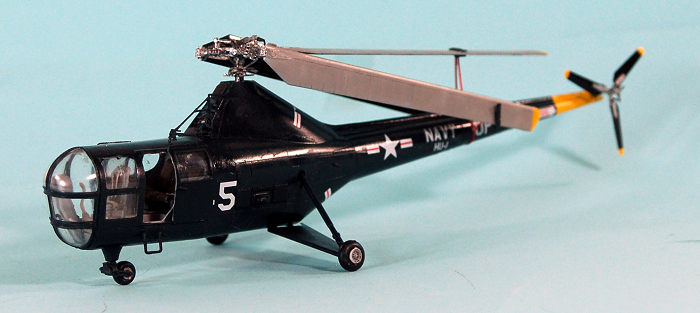 uld
since the model was an obvious tail-sitter. I then glued the fuselage together.
It was necessary to use Mr. Surfacer 500 on all the seams.
uld
since the model was an obvious tail-sitter. I then glued the fuselage together.
It was necessary to use Mr. Surfacer 500 on all the seams.
I then assembled the rotor hub, which was the most complex part of the project. About halfway through, I realized the rotor blades would not have much support when extended. I noted however, that the assembly would allow the blades to be folded. This led to a search for photos of the brace gear for the folded blades, and I saw it would not be too difficult to scratchbuild that. There was the additional benefit that the finished model would not take up too much space with the rotor.
The most difficult part of the assembly was fitting the photoetch shutters to the engine intake. The opening needed to be cut away to enlarge it so the delicate photoetch part would fit. This took about 30 minutes of cut and test to accomplish. I then attached the landing gear and masked the canopy - fortunately the kit includes masks for this.
| COLORS & MARKINGS |
I painted the model with Xtracrylix Dark Sea Blue overall, then applied a coat of clear gloss to protect the paint. I chose to do the HU-2 “Horse” for its obvious sentimentality with the movie. The decals went on without problem.
 Referencing
photos found on the internet, I made the rotor brack from Evergreen strip and
glued it in place on the model. The blades attached just as they should.
Fortunately I had put in enough weight that the model was still a nose-sitter
even with the additional mass of plastic all aft of the main gear with the
blades folded.
Referencing
photos found on the internet, I made the rotor brack from Evergreen strip and
glued it in place on the model. The blades attached just as they should.
Fortunately I had put in enough weight that the model was still a nose-sitter
even with the additional mass of plastic all aft of the main gear with the
blades folded.
| CONCLUSIONS |
The HO3S-1 is iconic for any Korean War model collection. Stories of daring rescues of shot down crews and pilots getting out of airplanes short-shot from carrier catapults are legion. Three HO3S-1 pilots were awarded the Medal of Honor for their work. One received medals from both the Royal Navy and the US Navy for his work while operating from HMAS Sydney in rescuing a Firefly crew shot down far behind enemy lines, the only person to receive two different medals from two different countries for the same mission.
This kit is easy to build if you have experience with limited-run kits and is vastly superior to the kits done before its release.
8 March 2018
Copyright ModelingMadness.com
Thanks to AMP for the review kit.
The story of Chief Thorin is from my coming book: “A Long Hard Slog: Naval Aviation in the Korean War.”
If you would like your product reviewed fairly and fairly quickly, please contact the editor or see other details in the Note to Contributors.
Back to the Main Page Back to the Review Index Page Back to the Previews Index Page